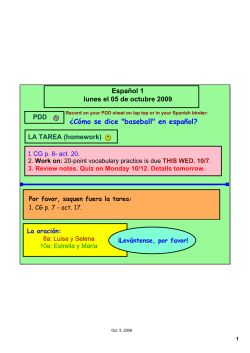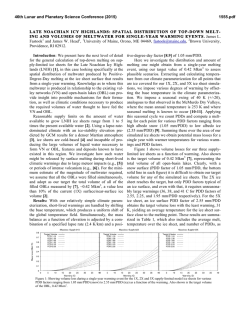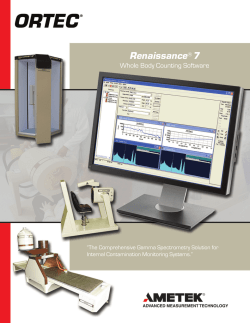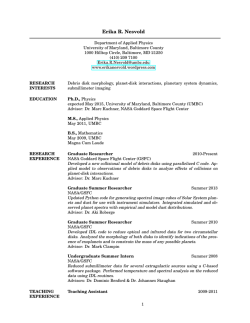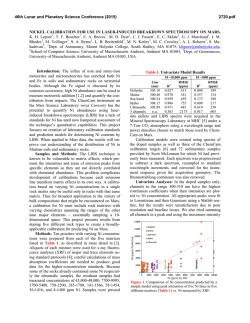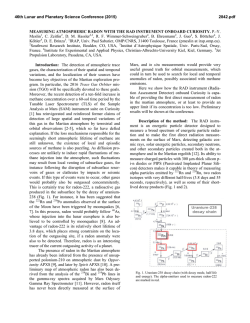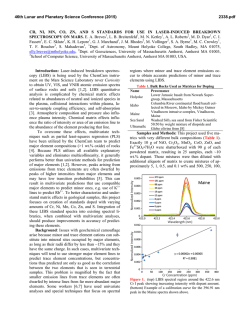
2191
46th Lunar and Planetary Science Conference (2015) 2191.pdf PIEZOELECTRIC DUST DETECTOR DESIGN AND CALIBRATION FOR THE ARMADILLO PROGRAM. F. Odom III1, G. Richter1, J. Brown1, B. Martinsen1, R. Cai1,4, M. Fellows1, A. Wolf1,2, C. Montag1,5, P. Young1, J. A. Carmona-Reyes1, J. Schmoke1, M. Cook1, B. Garner4, I. Gravagne4, K. Pin1, L. Shedd1, T. Groskreutz1, T. Hegle1, N. Mulenos1, J. Stone1, C. Wiley1, V. Yanga1, D. Eustice1, K. Flachsbart1, N. Steele1, C. Tilley1, P. Friudenberg1, D. Penshorn1, L. Henderson1, E. Cavazos1, A. Nabili1, E. Cox1, A. Cox1, J. Wood1, L. Devine1, J. Curran1, A. Mendiola1, C. Falkner1, R. Laufer1,2, R. Srama1,2, K. E. Schubert4, L. S. Matthews1, G Lightsey3 and T. W. Hyde1, 1CASPER (Center for Astrophysics, Space Physics and Engineering Research), Baylor University, Waco, TX 76798, [email protected]. 2Institute of Space Systems, University of Stuttgart, Raumfahrtzentrum Baden-Württemberg, Pfaffenwaldring 29, 70569 Stuttgart, Germany 3Space Systems Design Laboratory, Georgia Tech University, Atlanta, Georgia 30332. 4Department of Engineering, Baylor University, One Bear Place #97356, Waco, TX 76798-7356, USA. 5Institute of Aerospace Engineering, Technical University of Dresden, Marschner Strasse 32, 01062 Dresden, Germany. Introduction: ARMADILLO (Attitude Reference Maneuvers And Debris Instrument in Low Orbit) is a CubeSat currently slated to fly either April 2015 or January 2016. Armadillo is being built in partnership between Baylor University and the University of Texas at Austin and is funded by the University Nanosatellite Program (UNP), which is sponsored by the US Air Force. ARMADILLO’s primary science experiment is a Piezoelectric Dust Detector (PDD), which is being built by Baylor University’s Center for Astrophysics, Space Physics, and Engineering Research (CASPER). Once on orbit, ARMADILLO will be the first CubeSat to monitor in-situ space debris [1]. PDD Design, Calibration and Testing: ARMADILLO and the PDD will be placed in LowEarth Orbit (LEO) at an altitude of about 400 km, comparable to that of the International Space Station. At this altitude, there is a large amount of man-made space debris due to past satellites that were either destroyed or displaced once they were no longer functional [2]. Hardware Design: The PDD is comprised of two primary components. The Main Detector Unit (MDU) (fig. 1) consists of nine PZT sensors and two wire grids with the top grid of the MDU acting as both protective shield and ground. The second grid is charged providing a signal based on the charge produced by the vaporized dust particles. The Secondary Detector Unit (SDU) (fig. 2) is similar but consists of only a single PZT plate sensor, which is mounted on the side of the satellite towards the zenith. Both the MDU and SDU receive power and command instructions from the ARMADILLO satellite; the satellite in turn relays impact data to ground stations for processing and analysis. Software Design: The control software employed handles housekeeping communication with the primary CPU, data transmission and event detection. A key part of the software programming for this design is to establish a microprocessor structure on the FPGA, which will be used primarily for communicating with the satellite's computer. Figure 1. The PDD employs ten PZT plates—nine arranged in a 3-by-3-grid array (the Main Detector Unit or MDU and one on the Secondary Detector Unit or SDU). Figure 2. Stand-alone PZT plate used in the Secondary Detector Unit (SDU), which will be placed on the side of the ARMADILLO CubeSat facing the zenith. Initial Calibration: Initial bench–testing for the PDD was conducted employing a drop tower. Aluminum and stainless steel impactors were used in the calibration process with data captured via LabVIEW (fig. 3). Figure 3. Drop tower setup for typical 9 channel impact data collection. Each PZT is connected to a different channel on one of the three oscilloscopes shown. The data collected suggests the PDD should be able to withstand representative space debris impacts (with velocities determined using the Debris Assessment 46th Lunar and Planetary Science Conference (2015) Software suite - DAS version 2.0.2) over the predicted orbit [3]. It also will allow proper analysis of in-situ data. Prior to launch, additional calibration runs will be conducted using CASPER’s light gas gun [4]. 2191.pdf raw data and data collected by the PDD onboard computer. Fourier analysis of this data showed a resonant Figure 4. PDD vacuum test. This initial test lasted 9.5 hours while thermistors placed in key sections of the PDD were monitored. Thermal testing: A thermal stress test was conducted to determine whether the PDD would function properly under near Earth space environmental conditions (i.e. 1×10− 2 Torr or lower), where it becomes much more difficult for heat to dissipate from the system (fig. 4). Under normal temperature and pressure conditions, the PDD electronics were operated at full power over an extended period of time. Using an infrared camera, sixteen “hot-spots” were identified on the various electronics boards. Subsequently, the PDD was operated at 10 mTorr with thermistors placed at each “hot-spot” location while the PDD was brought to full power. Temperatures were collected across all 16 channels at three-second intervals over a period of 9.5 hours. The highest temperature reading on any one channel corresponded to the channel monitoring the memory chip; after two hours of run time, this temperature stabilized at 51 degrees Celsius (well below the maximum operational temperature for the chip), where it remained for the remainder of the experiment. Data Analysis: As impactor energy increases, the transferred energy deforms the PZT, producing an electrical charge due to the piezoelectric effect. Depending on velocity, a linear relationship will exist between the impact energy of the impactor and the PZT voltage, up to mechanical and electrical limits. Representative data for this process is shown in figure 5. For the proposed orbit, DAS 2.0.2 predicts the PDD will primarily observe µm space debris (at 10 km/s) having an energy range of 2 × 10− 7 J to 3 × 10-4 J. In order to properly analyze the in-situ data collected by the PDD, all nine PZTs within the MDU should register a calibrated signal. In order to establish this calibration, raw data from the drop tower (as collected by the oscilloscopes) was modeled as a damped harmonic oscillator: V (t) = A e− βt sin[ωt + φ] Where β represents the decay constant of the signal. An independent decay constant for each set of data was extracted in order to allow comparison between the Figure 5. Typical response of the MDU PZT matrix. V is peak-to-peak voltage, E is the impact energy. frequency of 98 kHz and a decay constant of 5000 as compared to the PDD onboard computer data which showed a resonant frequency of 110 kHz and a decay constant close to 5000. The difference in these results may be attributed to the difference in sampling rates between the oscilloscopes employed and the PDD. (The oscilloscope-sampling rate is 2.5 MHz while the PDD sampling rate is 1 MHz). To a first order of approximation, these results provide high enough precision to assess impact magnitudes and determine PZT plate integrity through monitoring of the resonant frequency shift and changes in decay constant magnitude. Conclusions: Initial tests and unit calibration have been conducted to identify all necessary PDD characteristics. Using these results, impact energies of in-situ space debris can be predicted through measurement of the peak-to-peak voltage, as defined by the linear fit model presented here (see fig. 5). It has also been shown that this signal can additionally be characterized using Fourier analysis and nonlinear modeling to extract vibrational frequencies and decay constants, respectively. The same signal analysis techniques will be used to estimate space debris collision and determine PZT plate integrity. Finally, it has been shown that the PDD should survive space conditions without excessive thermal stress to any of its components. References: Brumbaugh, K. M., Kjellberg, H. C., Lightsey, E. G., Wolf, A., Laufer, R. (2012). Advances in the Astronautical Sciences. [2] Shell, J. R. (2010) DTIC Document. [3] Opiela, J. N., Hillary, E., Whitlock, D. O., & Hennigan, M. (2007). Astromaterials Research and Exploration Science Directorate, Orbital Debris Program Office. [4] Carmona-Reyes, J., Cook, M., Schmoke, J., Harper, K., Reay, J., Matthews, L., & Hyde, T. W. (2004) 35th COSPAR Scientific Assembly, 35, 794.
© Copyright 2025
